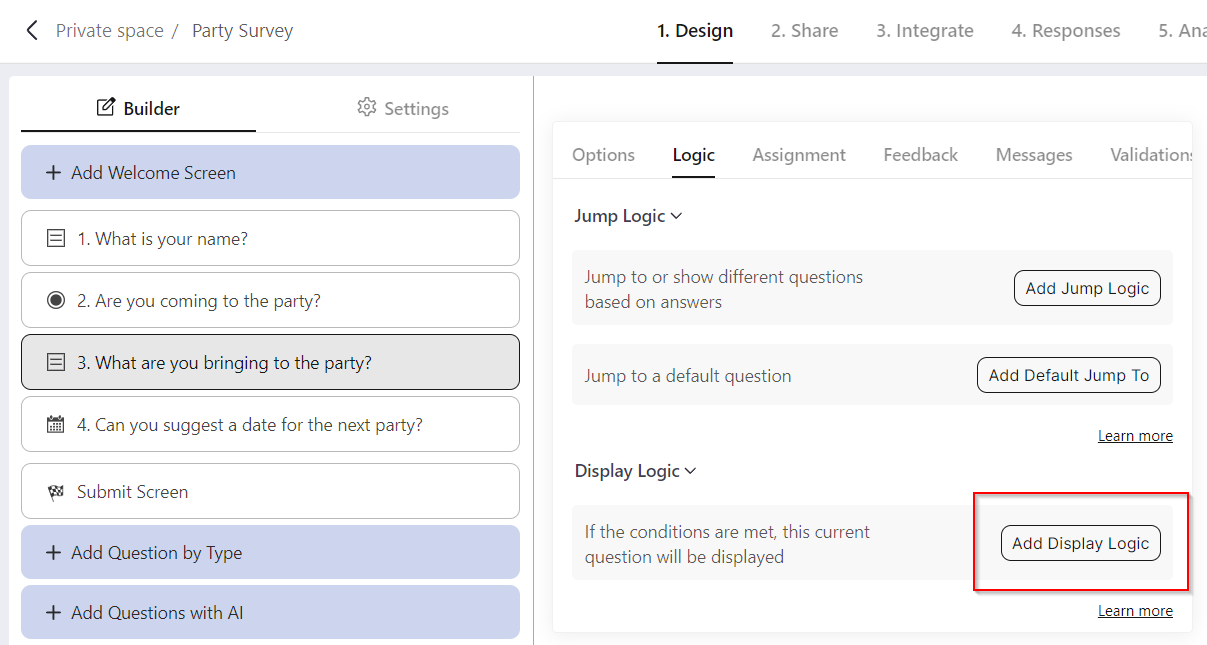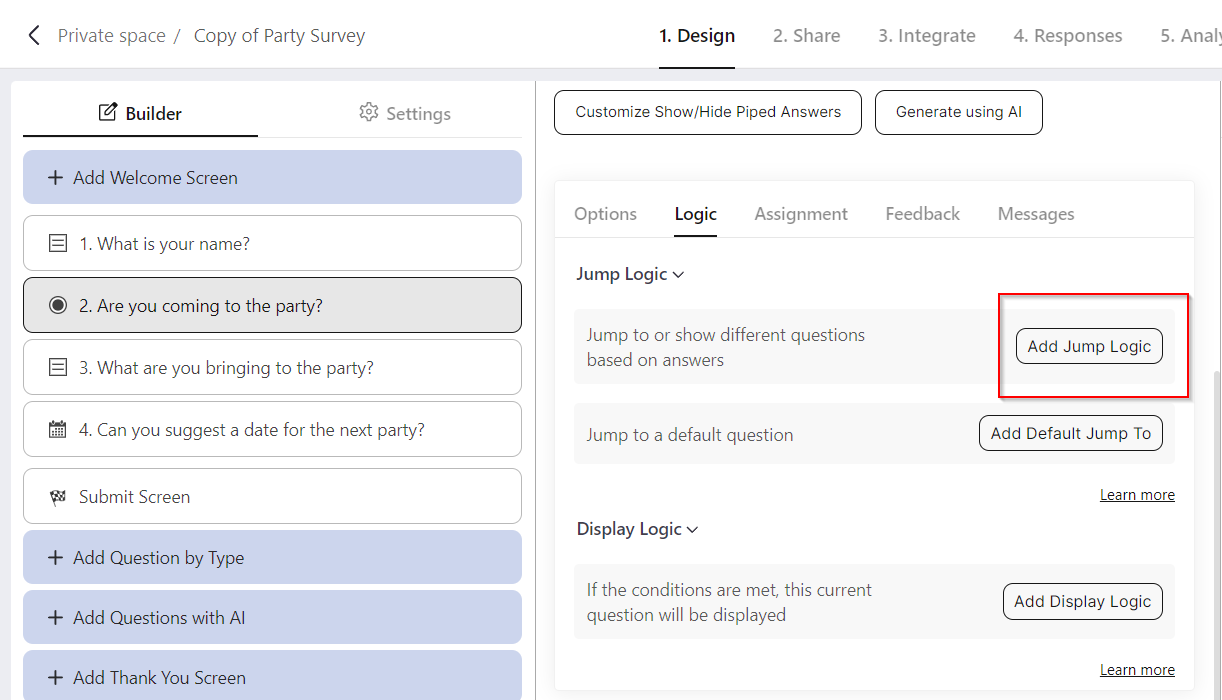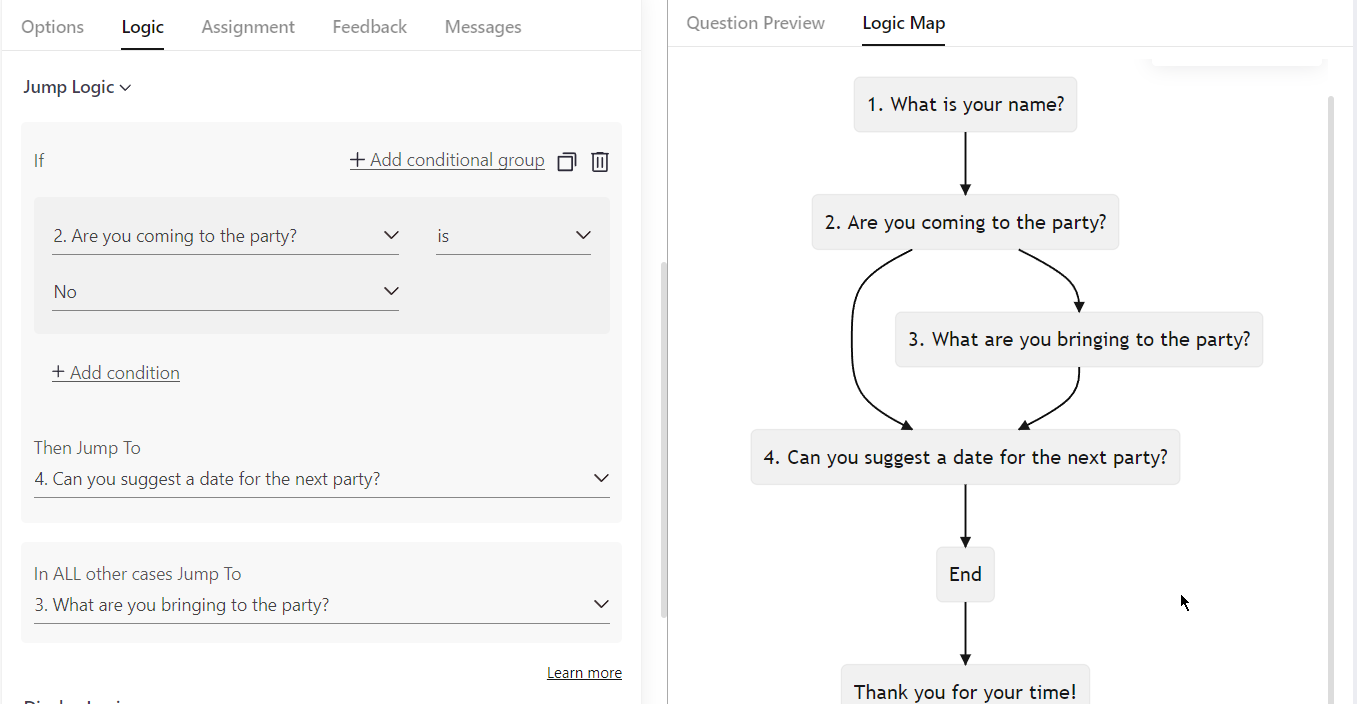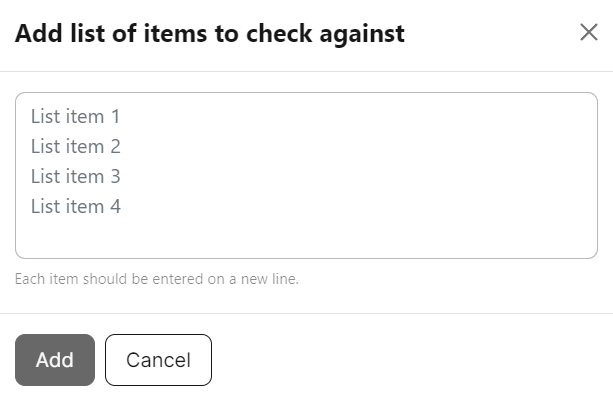Get insights.
Unlock value.
- 14-day free trial
- Set up in minutes
- No credit card required
Using Display And Jump Logic In Surveys
What You’ll Learn
By the end of this lesson, you’ll be able to:
- Understand the Display Logic feature of BlockSurvey.
- Understand the Jump Logic feature of BlockSurvey.
- Use both Display & Jump Logic in surveys and get meaningful data.
1. Setting the Stage
Consider that you are conducting a survey for an upcoming party that is happening in a restaurant. In the survey, you ask whether the respondent is coming to the restaurant party. One of the respondents, Karen, replies not come to the party. Then why ask Karen what she brings to the party? When Karen is not coming to the party, there is no point in asking what she brings to the party. This is the whole point behind the usage of display and jump logic.
In short, you can either display or jump to a survey question based on the answer to the previous question.
We will discuss Display and Jump Logic in the survey context with the following 4 questions.
- What is your name?
- Are you coming to the party?
- What are you bringing to the party?
- Can you suggest a date for the next party?
BlockSurvey supports both Display and Jump Logic. Although Display and Jump Logic have entirely different features, this module covers both Display and Jump Logic. You'll receive a holistic view of both these features through this module.
2. Display Logic
Display Logic shows or hides a survey question based on the answers provided to the previous question.
2.1. When to use?
Take the same Party example that we already discussed in the introduction.
If the answer to the previous question “Are you coming to the party?” is no, we can hide the next question, “What are you bringing to the party?”. On the contrary, if the answer to the previous question is yes, we can display the next question, and receive responses.
2.2. How to use?
Choosing the option
For any question, go to the logic tab, and you can find the display logic option below Jump Logic, as shown in the screenshot below.

Setting Condition & Logic Map
As you can see in the screenshot below, we are setting a condition for the third question, “What are you bringing to the party?”.
We display the third question only after verifying if the answer to the previous question is Yes (i.e., Karen is coming to the party). On the contrary, if the answer to the second question is “No,” then the third question will be hidden.
You can also see the logic map here. It has a logical conclusion towards the end of the survey.

3. Jump Logic
Jump logic skips the current question and jumps to a targeted question based on the answers to the previous or current question.
3.1. When to use?
Once again, taking the Karen Party example, if the answer to the second question, “Are you coming to the party?” is no, we can jump to the fourth question, bypassing the third question, “What are you bringing to the party?”. On the contrary, if Karen comes to the party, we can ask her what she is bringing.
3.2. How to use?
Choosing the option
For any question, go to the logic tab, and you can find the Jump logic option as the first option above Display Logic, as shown in the screenshot below.

Setting Condition & Logic Map
As you can see in the screenshot below, we are setting the condition for the second question, “Are you coming to the party?”.
We jump to the fourth question (Can you suggest a date for the next party?); if the answer to the second question, “Are you coming to the party?” is No (i.e., if Karen is not coming to the party).
For all other cases, we are jumping to the third question, “What are you bringing to the party?”.
The logic map is also shown below, once again reaching a logical conclusion towards the end of the survey.

4. Compare Options
In BlockSurvey, while setting conditions for Display and Jump Logic, 4 types of comparisons can be done. These 4 comparisons are listed below.
- is
- is not
- in
- not in
As seen in sections 2 & 3, ‘is’ used to verify the answer to any question. ‘is not’ is also used for the same purpose.
When you select ‘in’ or ‘in not,’ you will receive a prompt to enter your list of items to be checked against. Find the screenshot below for the prompt to enter a list of items. The answer is checked against this list of items.

5. Benefits of Display and Jump Logic
5.1. Targeted Questioning
A well-known benefit of branching is Targeted Questioning. As seen in the example, if someone mentions coming to the party in one question, you can use jump logic to immediately ask what they are bringing to the party in subsequent questions. This is targeted questioning.
5.2. Survey Shortens
Jump logic can significantly shorten the survey length for respondents. Instead of making them go through every question, you can guide them to the questions relevant to their responses.
5.3. Engages Respondents
The surveys that use display and jump logic are dynamic & interactive. Instead of a sequential set of questions, respondents navigate through the survey based on their answers. This makes the survey experience feel more conversational and engaging.
5.4. Gathers Relevant Data
Display and Jump logic ensures that respondents only answer questions relevant to them. Respondents are more likely to provide accurate, precise, and detailed responses by answering relevant questions.
6. Handy Tips To Follow
6.1. Balanced Branching
While applying display and jump logic is great for surveys, care should be taken not to overdo the logic. The displays and jumps should not be confusing. Make sure that the flow is intuitive and easily understood.
6.2. Clear Indications
When you are jumping questions, it is essential to let the respondents know. Provide clear instructions on what you are doing. For example, it could be something like, "Based on your previous answer, the next set of questions will be about XYZ.”
6.3. Avoid dead ends
In our branching, no matter what path the respondents take, they should always reach a logical conclusion towards the end of the survey. Care should be taken to avoid dead ends, which may irritate the respondents and lead to survey abandonment.
Test Your Knowledge
Using Display And Jump Logic In Surveys FAQ
What is display logic in surveys?
Display logic allows survey creators to control which questions or sections of a survey are shown to respondents based on their previous answers.
How can display logic improve survey response rates?
Display logic ensures that respondents only see relevant questions, making the survey more engaging and also reducing survey fatigue.
What is jump logic in surveys?
Jump logic automatically takes respondents to a specific question or section based on their previous answers, skipping irrelevant questions.
How does jump logic benefit survey design?
Jump logic streamlines the survey experience by eliminating unnecessary questions, making it more efficient and user-friendly.
Can I use display and jump logic together in surveys?
Yes, display and jump logic can be used in combination to create highly customized surveys that adapt to respondents' answers.
Get insights.
Unlock value.
- 14-day free trial
- Set up in minutes
- No credit card required
